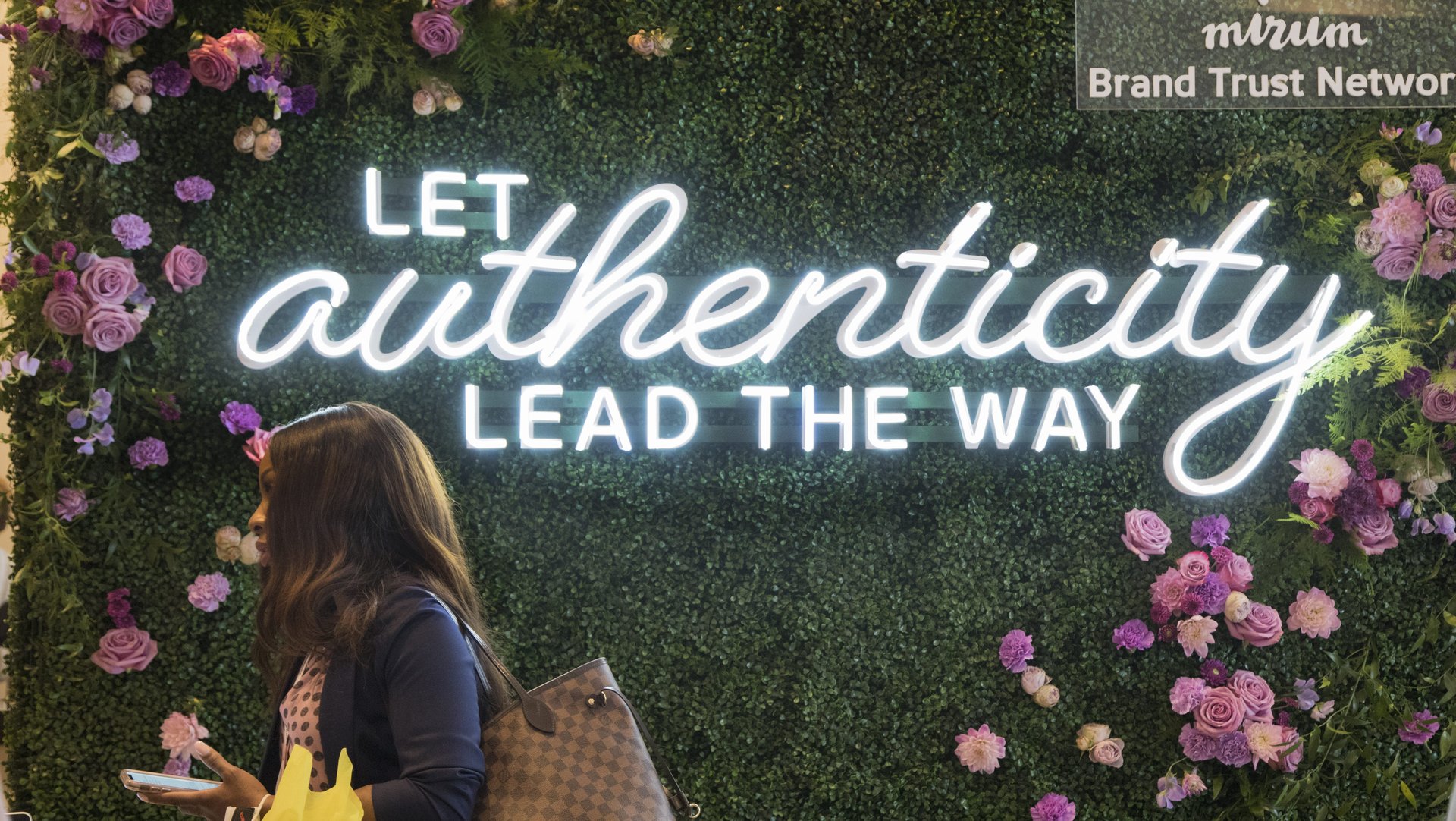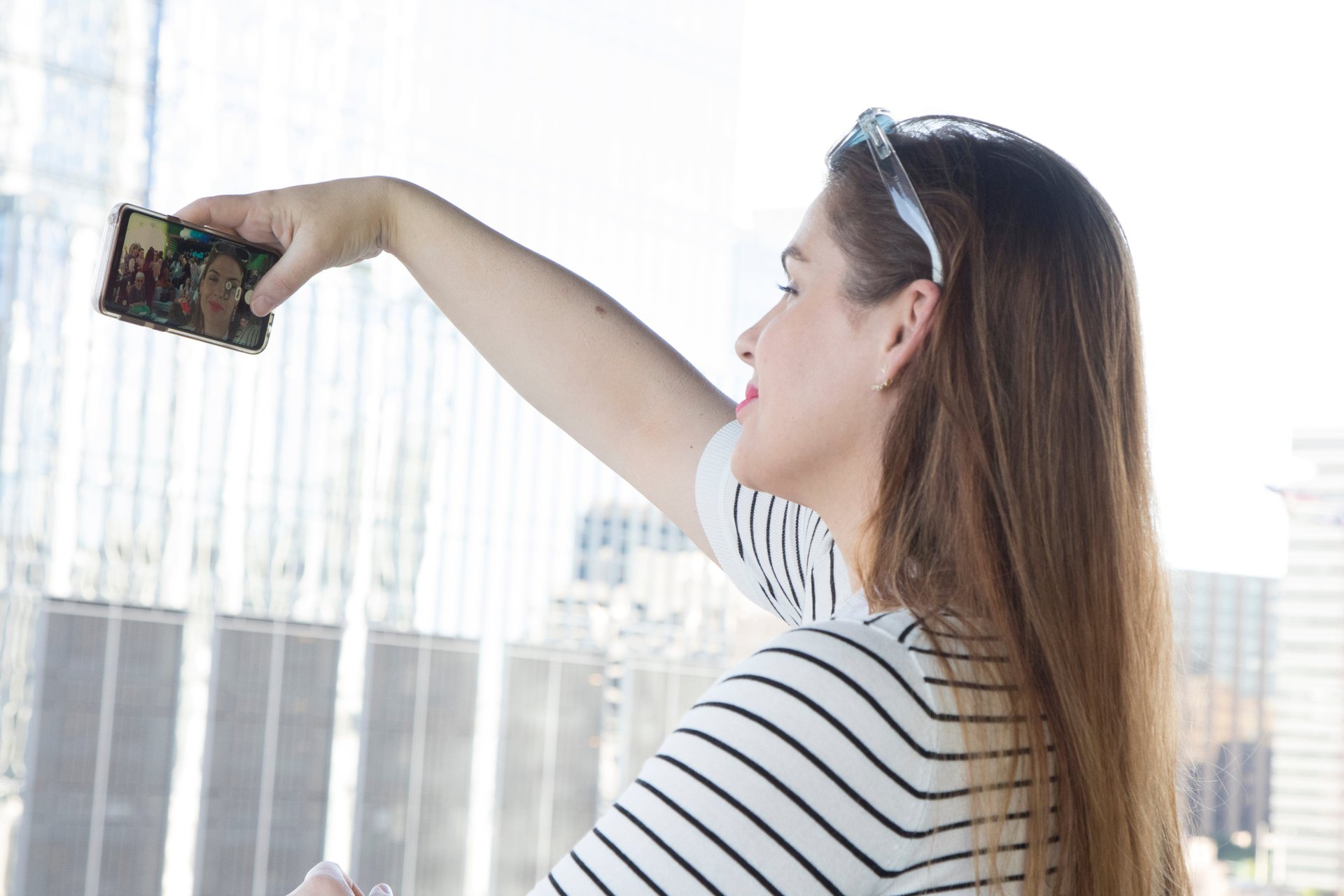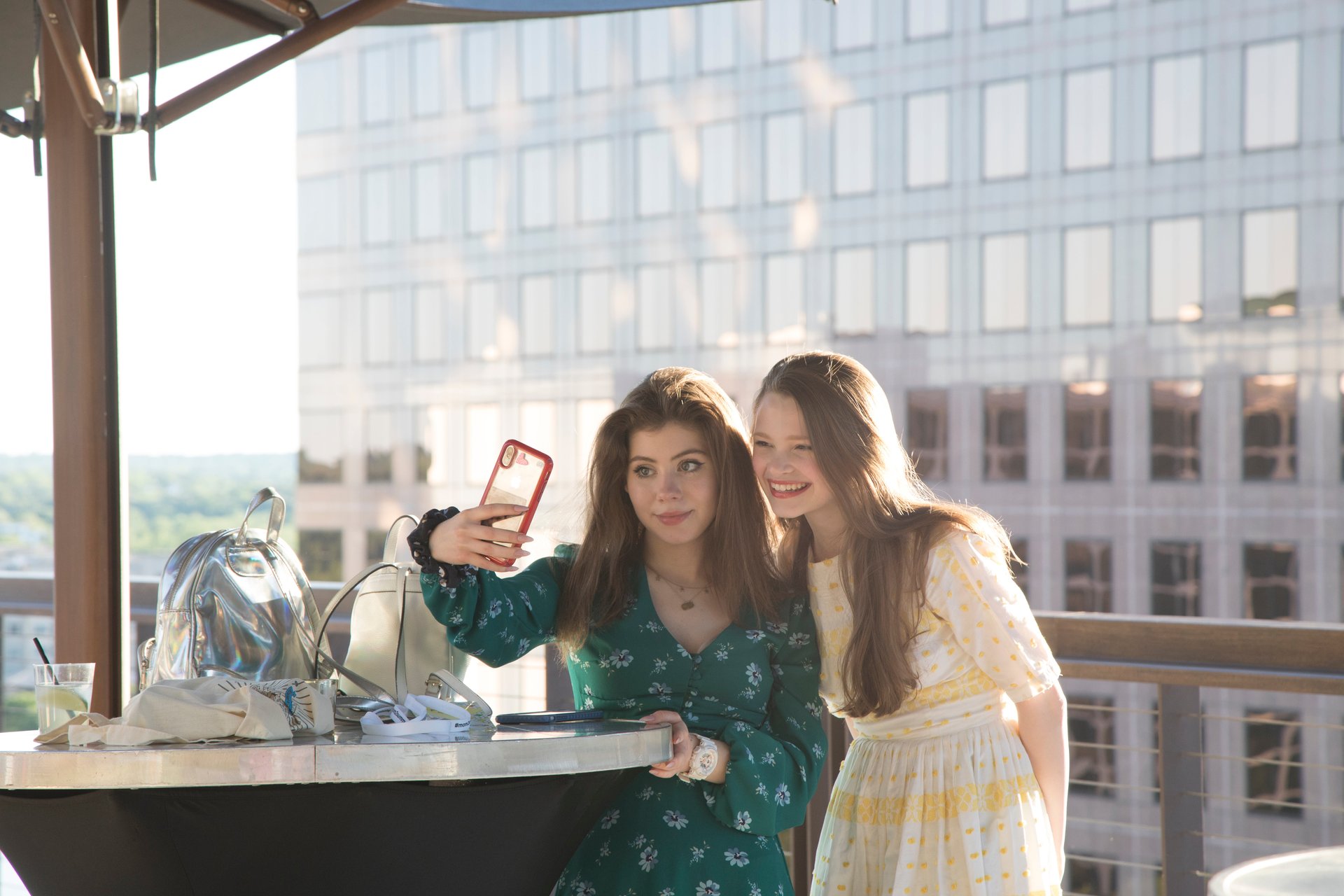Authenticity is the biggest challenge of the influencer world
At 6:45 am on a Thursday in late April, about two dozen women lined up yoga mats in several rows on the damp, chilly concrete of the Austin Marriott deck. You could see the glistening Colorado river, and the smell of barbecue was already wafting from the city’s restaurants. The yoga class itself would be unremarkable, except for one mantra you don’t hear at your neighborhood Vinyasa session. “When you’re in ‘Warrior Two,’ you find your authenticity,” the teacher cheered on her students. “Despite all the noise, when you find your authenticity, you resonate inward and with the rest of the world,” she said. Moments later a worker wielding a leaf blower interrupted the yogic calm.


At 6:45 am on a Thursday in late April, about two dozen women lined up yoga mats in several rows on the damp, chilly concrete of the Austin Marriott deck. You could see the glistening Colorado river, and the smell of barbecue was already wafting from the city’s restaurants. The yoga class itself would be unremarkable, except for one mantra you don’t hear at your neighborhood Vinyasa session. “When you’re in ‘Warrior Two,’ you find your authenticity,” the teacher cheered on her students. “Despite all the noise, when you find your authenticity, you resonate inward and with the rest of the world,” she said. Moments later a worker wielding a leaf blower interrupted the yogic calm.
The mantra, which would be repeated no fewer than five times during the 45-minute class, was tailored to the audience: a crowd of bloggers, influencers, and marketers in the world of online parenting, often somewhat disparagingly called “mommy blogging.” They had gathered at a long-running conference for mompreneurs. “Authenticity” would come up many more times.
“Authenticity” is what influencers are supposed to lend the brands they promote. Marketers value their content as more honest and grounded than traditional advertising. But this central tenet of the influencer economy is also the fulcrum of most of its problems. Critics see the professed sincerity as contrived. As they see it, authenticity is being co-opted in the interests of a fabricated reality. This comes into sharp focus when influencers buy fake followers, hawk sketchy products, or fail to disclose that they’ve been paid to promote something. Authenticity is also an incredibly squishy concept, making it difficult for influencers themselves to grapple with it, consumers to judge it, and, importantly, for governments to regulate it.

What is an “authentic” audience?
The size of an influencer’s audience is an important currency in the marketing economy. Influencers with more followers can often get better deals from brands. However, the tactics some influencers use to gain more followers aren’t always so “authentic.”
Buying followers is as easy as buying a pair of shoes online. In some arrangements, tens of thousands of bots will follow your account. Other services let participants swap “follows” with others.
Buying engagement—likes and comments—is also possible. Numerous companies sell “likes,” some for as little as $.01 a piece. A site called Skweezer, which serves all your Instagram-gaming needs, sells fifty custom comments for $17.99.
Artificially inflating audience numbers can get influencers into legal trouble. Amanda Schreyer, attorney for the law firm Morse Barnes-Brown Pendleton who specializes in intellectual property says it’s fraud. It could also be a breach of contract. “Brands are actually requiring the influencers to make a representation that none of their followers have been purchased or acquired by fraudulent means,” she said.

No brand wants to spend money reaching an army of bots, and marketers see artificially inflated audience metrics as a top challenge to influencer marketing. Some companies use special tools to detect fake followers by spotting sudden spikes or other abnormalities in audience metrics. But a report from Points North Group, a social media measurement and screening company, estimated that $102 million, or nearly 14% of influencer budgets for marketers in the US and Canada were still wasted on fake followers in 2018.
That same year, Unilever announced it would not work with influencers that engage in dishonest practices like inflating audience numbers because, it said in a press release, they “will erode trust in the whole ecosystem.” Yet the Points North Group report estimated that about 25% of followers for Unilever-owned Dove’s Instagram influencers in 2018 were fake. The industry average is 14%.
Platforms like Instagram and Twitter have declared they’d crack down on fake followers, likes, and comments, and the government is slowly getting involved as well. In a landmark case, following a New York Times investigation, the New York attorney general’s office reached a settlement with Devumi, a company that sold millions of fake followers on Twitter and other social networks to at least 200,000 customers.
Sometimes, inflating engagement looks more like a trade than a transaction. Influencer pods are groups of influencers who band together to boost other member’s posts, by liking and commenting on them.
But, again, this is not the engagement brands are looking for. Auto company Kia shut down its ambassador program after it discovered the robust interactions it was seeing on different influencer accounts were all coming from the same people, in an echo chamber of sorts, James Bell, the company’s head of PR, told Quartz.

What is an “authentic” endorsement?
Most truth in advertising regulations weren’t made for the age of Instagram, and there’s considerable confusion over the legal line between an authentic social media endorsement and a paid ad, which influencers are required to disclose.
The US Federal Trade Commission (FTC) took its first action against influencers themselves in 2017. It sent letters to 90 influencers and marketers detailing how they had purportedly failed to clearly explain that their relationships were part of a brand’s promotion. This resulted in some hilarious government documents, with FTC officials gently scolding influencers for their Instagram posts about “cute” lip masks and pinky rings.
But a number of the posts the FTC mentioned in these letters were seemingly not ads at all, or the commercial relationship wasn’t black-and-white. Actress Shay Mitchell, for example, posted a photo of Kettle Chips, but its maker doesn’t sponsor her in any way, it confirmed to Buzzfeed News. Heidi Klum is not directly paid by Dunkin’ Donuts, as she adamantly claimed, but the company does sponsor America’s Got Talent, a show she appears on.
How can regulators really determine that something is an honest endorsement or a paid sponsorship, or whether an influencer had actually used and liked a product?
The FTC mandates that an endorsement reflect “an honest opinion of the endorser and can’t be used to make a claim that the product’s marketer couldn’t legally make.” The influencers have to have used a product in order to give their recommendation, and the claims can’t be unsubstantiated, Schreyer said. In addition, influencers have to include a “clear and conspicuous” disclosure on social media posts for which they were paid.
Here are some examples of the guidelines the FTC offers to help creators and brands adhere to the rules:
- The disclosure should be near the top of a post.
- Hashtags like #ad or #sponsored are acceptable, but hashtags like #sp, #spon, or even #partner, are not.
- Special tags provided by Instagram and Facebook that indicate on top of a post that it was a “partnership with X brand” are also not sufficient.
- Crucially, disclosure rules also cover payment in kind, like products that are gifted, even if influencers are not compensated with cash.
Influencers often flout ad disclosure guidelines to avoid being seen as company shills, but also because they aren’t always entirely aware of them. Several of the influencers I spoke with, when describing their disclosure practices, erroneously claimed for example that when they were just compensated with a free product, the rules didn’t apply.
Not following the rules can come with legal consequences. Three attendees of the ill-fated Fyre Festival, for instance, sued both the festival’s organizers and the 100 influencers who promoted it, accusing them of fraud and misrepresentation. Former boxer Floyd Mayweather Jr. and producer DJ Khaled settled in November with the US Securities and Exchange Commission for not disclosing on social media that they were paid for promoting investments in Initial Coin Offerings (ICOs). They had to pay hundreds of thousands of dollars in penalties.
Still, the consequences for inadequate disclosures have not been particularly severe.
At least 21 of the 90 influencers to whom the FTC sent letters in 2017 ignored them, and the agency issued them warnings. A subsequent review by advocacy group Truth In Advertising (TINA) looked at the accounts of those 21 influencers, who have anywhere from 750,000 followers to more than 32 million. It showed that all but one failed to “consistently and appropriately disclose their material connections to the brands they are promoting.”
The FTC doesn’t actively seek out violators—it even says so on its website. Instead it relies on consumers or groups like TINA to report bad behavior.
Brands have started requiring influencers to follow the disclosure rules, because ultimately, it’s the brands that can get into the biggest trouble. Since 2011, the FTC launched 13 investigations into influencer marketing. In seven of the cases, the agency entered into consent orders with companies and agencies. They did not result in any financial penalties, but Schreyer said these agreements are long and burdensome, as well as bad PR.
The somewhat vague and lagging regulations and laws can have serious consequences. Pharmaceutical products have been marketed without proper disclosure of risks. Child influencers are another good example. On US television, laws limit the amount of commercials during children’s programming. “What’s long been recognized is that because children are developmentally vulnerable to advertising, they benefit if there’s a clear separation [between programming and commercials],” Josh Golin, executive director of the Campaign for a Commercial-Free Childhood, told Quartz in November. On the internet that separation disappears, since kids are watching YouTube videos all the time, and a lot of the content made for children—like “unboxing” videos, where kidfluencers open toys—is sponsored.

The campaign has asked the FTC to investigate companies like Google and Disney for deceptive marketing toward children through influencers, calling for a stop to the practice.

What does “authenticity” even mean?
The same gray areas that make it hard to determine the difference between influencer’s ads and normal posts also make it hard to determine what “authenticity” on social media means.
Influencers say their sponsored posts are authentic, because they genuinely like and use the products they promote. But those posts are also intentionally meant to blend in with their organic content (that’s why some influencers, as I heard from an agent, charge more to promote brands that are less sexy and cool—it’s harder to make their endorsements “authentic”). This can have a confusing effect for the audience, especially if the paid engagements are not adequately disclosed. It raises questions. When am I being advertised to? Can I trust this recommendation or this review? Is this ad copy, or someone’s real opinion?
Brands prefer to tout the influencer marketing they do as less transactional and more natural than traditional advertising. They like to emphasize how the best ambassadors are the people who love their products, and they are cagey when asked about paid engagements. “We know that relationships are built, not bought,” said Selena Kalvaria, VP of brand marketing at luggage company Away. Bell, the PR head for Kia, who is re-envisioning the company’s influencer programs, said he was not looking for “hired guns.” Of course not. They are inherently less authentic. (On the other hand, some brands go a completely opposite route, defying all notions of authenticity by using fake influencers, created through artificial intelligence).
It’s possible that the credit influencers once got for their authenticity is running out. In a report for research firm Forrester, its marketing analysts note that they expect over time that people will eventually “ascribe no more trust to influencers’ branded content than to brands themselves.” Other forms of “word of mouth” marketing—such as content that comes from regular customers who like a brand, and want to be affiliated with it—will likely win out in the authenticity race, the analysts say.
After all, when authenticity becomes a commodity, is it still authentic?
Influencers struggle with this question themselves, deciding on how curated their feeds should be, how much to share of their lives, when to skip a dark moment, and when to show vulnerability to their audiences, in the name of presenting their true selves. Finding that “inner authenticity” from the morning yoga class, and letting it “resonate with the world” is quite fraught.
Some former bloggers interviewed by sociologist Brooke Erin Duffy for her book “(Not) Getting Paid to Do What You Love” saw the professionalization of blogging as a loss of “realness.” One of them told her that “(r)eality is blogging about things you do, wear, care about—not wearing, doing, caring about things so that you have something to blog about.”
A fashion influencer I spoke to said she wanted to move away from highly produced, highly curated images in her Instagram profile to include more day-to-day moments—snapshots instead of meticulous photo shoots. She said it would fit in her life better as she is planning on having kids. “If I’m going to get pregnant and have like two, three kids, it’s going to be pretty tough to go through a flower field and take photos.” But just a breath later, she added that she’d been hearing “chatter” that Instagram’s algorithm was favoring less-edited images. These two motivations might seem contradictory, but this is how the influencers have to think about their work. Authenticity is in many ways defined by the influencer economy and the digital age. “We can see that the imperatives to express oneself authentically and manage one’s digital image are not inconsistent. Instead, they are woven from the same cloth, namely the pervasive cult of self-branding,” Duffy writes.
LaShawn Wiltz, who blogs about motherhood, did a week-long challenge for her followers in which she asked them to share selfies interpreting a prompt that she’d give them. For Day 4, the prompt was “no filter:”
In the world of Instagram we have become this filtered version of ourselves. We filter our looks: cloning out blemishes, smoothing our skin, making ourselves skinnier….We filter our thoughts because must be politically correct so everyone likes us! We filter our words. Because we don’t want to lose friends or followers or clients or be cancelled. But where does that leave us? What is even real anymore? How can we, as people who share our lives online be authentic and not afraid to show who we really are.. Unfiltered?
All of that filtering, the perfect feeds filled with beautiful products, influencers who are or portray themselves as real, relatable people, can create an illusion that an Instagram life is easy and attainable. Of course, it’s not.
Because they are tasked with upholding and projecting their authenticity, influencers get bashed when they transgress against it. But the problem is that this “authenticity” is projected and produced through social media, which is in turn constructed upon filters, upon the idea of curation. Upon a certain inauthenticity.